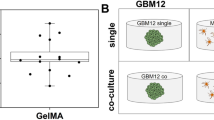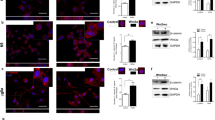Abstract
High-grade gliomas are the most common primary brain tumors. Their malignancy is promoted by the complex crosstalk between different cell types in the central nervous system. Microglia/brain macrophages infiltrate high-grade gliomas and contribute to their progression. To identify factors that mediate the attraction of microglia/macrophages to malignant brain tumors, we established a glioma cell encapsulation model that was applied in vivo. Mouse GL261 glioma cell line and human high-grade glioma cells were seeded into hollow fibers (HF) that allow the passage of soluble molecules but not cells. The glioma cell containing HF were implanted into one brain hemisphere and simultaneously HF with non-transformed fibroblasts (controls) were introduced into the contralateral hemisphere. Implanted mouse and human glioma- but not fibroblast-containing HF attracted microglia and up-regulated immunoreactivity for GFAP, which is a marker of astrogliosis. In this study, we identified GDNF as an important factor for microglial attraction: (1) GL261 and human glioma cells secret GDNF, (2) reduced GDNF production by siRNA in GL261 in mouse glioma cells diminished attraction of microglia, (3) over-expression of GDNF in fibroblasts promoted microglia attraction in our HF assay. In vitro migration assays also showed that GDNF is a strong chemoattractant for microglia. While GDNF release from human or mouse glioma had a profound effect on microglial attraction, the glioma-induced astrogliosis was not affected. Finally, we could show that injection of GL261 mouse glioma cells with GDNF knockdown by shRNA into mouse brains resulted in reduced tumor expansion and improved survival as compared to injection of control cells.







Similar content being viewed by others
References
Badie B, Schartner J (2001) Role of microglia in glioma biology. Microsc Res Tech 54(2):106–113. doi:10.1002/jemt.112510.1002/jemt.1125
Badie B, Schartner J, Klaver J, Vorpahl J (1999) In vitro modulation of microglia motility by glioma cells is mediated by hepatocyte growth factor/scatter factor. Neurosurgery 44(5):1077–1082 (discussion 1082–1073)
Broadhead KW, Biran R, Tresco PA (2002) Hollow fiber membrane diffusive permeability regulates encapsulated cell line biomass, proliferation, and small molecule release. Biomaterials 23(24):4689–4699. doi:10.1016/S0142-9612(02)00212-0
Charles NA, Holland EC, Gilbertson R, Glass R, Kettenmann H (2011) The brain tumor microenvironment. Glia 59(8):1169–1180. doi:10.1002/glia.21136
Cornejo M, Nambi D, Walheim C, Somerville M, Walker J, Kim L, Ollison L, Diamante G, Vyawahare S, de Bellard ME (2010) Effect of NRG1, GDNF, EGF and NGF in the migration of a Schwann cell precursor line. Neurochem Res 35(10):1643–1651. doi:10.1007/s11064-010-0225-0
Dhandapani KM, Khan MM, Wade FM, Wakade C, Mahesh VB, Brann DW (2007) Induction of transforming growth factor-beta1 by basic fibroblast growth factor in rat C6 glioma cells and astrocytes is mediated by MEK/ERK signaling and AP-1 activation. J Neurosci Res 85(5):1033–1045. doi:10.1002/jnr.21182
Dudanova I, Gatto G, Klein R (2010) GDNF acts as a chemoattractant to support ephrinA-induced repulsion of limb motor axons. Curr Biol 20(23):2150–2156. doi:10.1016/j.cub.2010.11.021
Edwards LA, Woolard K, Son MJ, Li A, Lee J, Ene C, Mantey SA, Maric D, Song H, Belova G, Jensen RT, Zhang W, Fine HA (2011) Effect of brain- and tumor-derived connective tissue growth factor on glioma invasion. J Natl Cancer Inst 103(15):1162–1178. doi:djr22410.1093/jnci/djr224
Franklin K, Paxinos G (2007) The mouse brain in stereotaxic coordinates, 3rd edn. Academic Press, San Diego
Geranmayeh F, Scheithauer BW, Spitzer C, Meyer FB, Svensson-Engwall AC, Graeber MB (2007) Microglia in gemistocytic astrocytomas. Neurosurgery 60(1):159–166 (discussion 166). doi:10.1227/01.NEU.0000249192.30786.67
Glass R, Synowitz M, Kronenberg G, Walzlein JH, Markovic DS, Wang LP, Gast D, Kiwit J, Kempermann G, Kettenmann H (2005) Glioblastoma-induced attraction of endogenous neural precursor cells is associated with improved survival. J Neurosci 25(10):2637–2646. doi:25/10/263710.1523/JNEUROSCI.5118-04.2005
Han Q, Sun W, Lin H, Zhao W, Gao Y, Zhao Y, Chen B, Xiao Z, Hu W, Li Y, Yang B, Dai J (2009) Linear ordered collagen scaffolds loaded with collagen-binding brain-derived neurotrophic factor improve the recovery of spinal cord injury in rats. Tissue Eng Part A 15(10):2927–2935. doi:10.1089/ten.TEA.2008.0506
Hussain SF, Yang D, Suki D, Aldape K, Grimm E, Heimberger AB (2006) The role of human glioma-infiltrating microglia/macrophages in mediating antitumor immune responses. Neuro Oncol 8(3):261–279. doi:10.1215/15228517-2006-008
Kenig S, Alonso MB, Mueller MM, Lah TT (2009) Glioblastoma and endothelial cells cross-talk, mediated by SDF-1, enhances tumour invasion and endothelial proliferation by increasing expression of cathepsins B, S, and MMP-9. Cancer Lett 289(1):53–61. doi:10.1016/j.canlet.2009.07.014
Kim YT, Hitchcock R, Broadhead KW, Messina DJ, Tresco PA (2005) A cell encapsulation device for studying soluble factor release from cells transplanted in the rat brain. J Control Release 102(1):101–111. doi:10.1016/j.jconrel.2004.10.003
Kirik D, Georgievska B, Bjorklund A (2004) Localized striatal delivery of GDNF as a treatment for Parkinson disease. Nat Neurosci 7(2):105–110. doi:10.1038/nn1175nn1175
Koelsch A, Feng Y, Fink DJ, Mata M (2010) Transgene-mediated GDNF expression enhances synaptic connectivity and GABA transmission to improve functional outcome after spinal cord contusion. J Neurochem 113(1):143–152. doi:10.1111/j.1471-4159.2010.06593.x
Komohara Y, Ohnishi K, Kuratsu J, Takeya M (2008) Possible involvement of the M2 anti-inflammatory macrophage phenotype in growth of human gliomas. J Pathol 216(1):15–24. doi:10.1002/path.2370
Lang AE, Gill S, Patel NK, Lozano A, Nutt JG, Penn R, Brooks DJ, Hotton G, Moro E, Heywood P, Brodsky MA, Burchiel K, Kelly P, Dalvi A, Scott B, Stacy M, Turner D, Wooten VG, Elias WJ, Laws ER, Dhawan V, Stoessl AJ, Matcham J, Coffey RJ, Traub M (2006) Randomized controlled trial of intraputamenal glial cell line-derived neurotrophic factor infusion in Parkinson disease. Ann Neurol 59(3):459–466. doi:10.1002/ana.20737
Le DM, Besson A, Fogg DK, Choi KS, Waisman DM, Goodyer CG, Rewcastle B, Yong VW (2003) Exploitation of astrocytes by glioma cells to facilitate invasiveness: a mechanism involving matrix metalloproteinase-2 and the urokinase-type plasminogen activator-plasmin cascade. J Neurosci 23(10):4034–4043
Leung SY, Wong MP, Chung LP, Chan AS, Yuen ST (1997) Monocyte chemoattractant protein-1 expression and macrophage infiltration in gliomas. Acta Neuropathol 93(5):518–527
Lin LF, Doherty DH, Lile JD, Bektesh S, Collins F (1993) GDNF: a glial cell line-derived neurotrophic factor for midbrain dopaminergic neurons. Science 260(5111):1130–1132
Lu DY, Leung YM, Cheung CW, Chen YR, Wong KL (2010) Glial cell line-derived neurotrophic factor induces cell migration and matrix metalloproteinase-13 expression in glioma cells. Biochem Pharmacol 80(8):1201–1209. doi:10.1016/j.bcp.2010.06.046
Magge SN, Malik SZ, Royo NC, Chen HI, Yu L, Snyder EY, O’Rourke DM, Watson DJ (2009) Role of monocyte chemoattractant protein-1 (MCP-1/CCL2) in migration of neural progenitor cells toward glial tumors. J Neurosci Res 87(7):1547–1555. doi:10.1002/jnr.21983
Markovic DS, Glass R, Synowitz M, Rooijen N, Kettenmann H (2005) Microglia stimulate the invasiveness of glioma cells by increasing the activity of metalloprotease-2. J Neuropathol Exp Neurol 64(9):754–762. doi:00005072-200509000-00002
Markovic DS, Vinnakota K, Chirasani S, Synowitz M, Raguet H, Stock K, Sliwa M, Lehmann S, Kalin R, van Rooijen N, Holmbeck K, Heppner FL, Kiwit J, Matyash V, Lehnardt S, Kaminska B, Glass R, Kettenmann H (2009) Gliomas induce and exploit microglial MT1-MMP expression for tumor expansion. Proc Natl Acad Sci USA 106(30):12530–12535. doi:10.1073/pnas.0804273106
Markovic DS, Vinnakota K, van Rooijen N, Kiwit J, Synowitz M, Glass R, Kettenmann H (2011) Minocycline reduces glioma expansion and invasion by attenuating microglial MT1-MMP expression. Brain Behav Immun 25(4):624–628. doi:10.1016/j.bbi.2011.01.015
Okada M, Saio M, Kito Y, Ohe N, Yano H, Yoshimura S, Iwama T, Takami T (2009) Tumor-associated macrophage/microglia infiltration in human gliomas is correlated with MCP-3, but not MCP-1. Int J Oncol 34(6):1621–1627
Platten M, Kretz A, Naumann U, Aulwurm S, Egashira K, Isenmann S, Weller M (2003) Monocyte chemoattractant protein-1 increases microglial infiltration and aggressiveness of gliomas. Ann Neurol 54(3):388–392. doi:10.1002/ana.10679
Song H, Moon A (2006) Glial cell-derived neurotrophic factor (GDNF) promotes low-grade Hs683 glioma cell migration through JNK, ERK-1/2 and p38 MAPK signaling pathways. Neurosci Res 56(1):29–38. doi:10.1016/j.neures.2006.04.019
Visted T, Bjerkvig R, Enger PO (2001) Cell encapsulation technology as a therapeutic strategy for CNS malignancies. Neuro Oncol 3(3):201–210
Voisin P, Bouchaud V, Merle M, Diolez P, Duffy L, Flint K, Franconi JM, Bouzier-Sore AK (2010) Microglia in close vicinity of glioma cells: correlation between phenotype and metabolic alterations. Front Neuroenergetics 2:131. doi:10.3389/fnene.2010.00131
Wan G, Too HP (2010) A specific isoform of glial cell line-derived neurotrophic factor family receptor alpha 1 regulates RhoA expression and glioma cell migration. J Neurochem 115(3):759–770. doi:10.1111/j.1471-4159.2010.06975.x
Watters JJ, Schartner JM, Badie B (2005) Microglia function in brain tumors. J Neurosci Res 81(3):447–455. doi:10.1002/jnr.20485
Wiesenhofer B, Stockhammer G, Kostron H, Maier H, Hinterhuber H, Humpel C (2000) Glial cell line-derived neurotrophic factor (GDNF) and its receptor (GFR-alpha 1) are strongly expressed in human gliomas. Acta Neuropathol 99(2):131–137
Wiggins H, Rappoport J (2010) An agarose spot assay for chemotactic invasion. Biotechniques 48(2):121–124. doi:10.2144/000113353
Zhang GJ, Chen TB, Hargreaves R, Sur C, Williams DL Jr (2008) Bioluminescence imaging of hollow fibers in living animals: its application in monitoring molecular pathways. Nat Protoc 3(5):891–899. doi:10.1038/nprot.2008.52
Zhao D, Najbauer J, Garcia E, Metz MZ, Gutova M, Glackin CA, Kim SU, Aboody KS (2008) Neural stem cell tropism to glioma: critical role of tumor hypoxia. Mol Cancer Res 6(12):1819–1829. doi:10.1158/1541-7786.MCR-08-0146
Acknowledgments
This work was supported by the graduate school of NeuroCure at the Charité, Berlin, (stipend to M. C. Ku) and by Deutsche Forschungsgemeinschaft (TR 43). We are thankful to Prof. Carlos Ibanez for providing GDNF cDNA construct for transfection and Prof. Jochen Meier for providing human brain tissue. We thank Dr. Zoltan Cseresnyes and Dr. Anje Sporbert for technical assistance with confocal microscopy. We appreciate the support of Babette Dieringer for MR imaging and Maria Pannell for manuscript proof reading.
Conflict of interest
The authors declare that they have no conflict of interest.
Author information
Authors and Affiliations
Corresponding author
Electronic supplementary material
Below is the link to the electronic supplementary material.
401_2013_1079_MOESM1_ESM.tif
Supplemental Fig. 1 Time course of GL261 cell proliferation after siRNA transfection and encapsulated into HF was estimated using an Alamar blue assay. The results represent the mean ± s.e.m. from 5 fibers (TIFF 843 kb)
401_2013_1079_MOESM2_ESM.tif
Supplemental Fig. 2 a GDNF secretion from non-targeted shRNA treated GL261 cells (shNT) and GDNF shRNA treated cells (shGDNF) after one month of transfection was analyzed by ELISA (*p < 0.05). b After transfection with either shNT (left panel) or shGDNF (right panel), GL261 cells enclosed in HF were implanted into the mouse brains (left and right hemisphere, respectively). After 6 days of implantation, mice were sacrificed and brain sections were stained with Iba-1 (red) antibody. Cell nuclei were counterstained with DAPI (blue). Yellow dashed line indicates the border between HF and brain tissue. c Density of microglia surrounding HF with shGDNF transfected GL261 cells is shown (mean ± s.e.m. n = 5 mice; **p < 0.01) compared with control shNT GL261 cells. (TIFF 5381 kb)
Rights and permissions
About this article
Cite this article
Ku, MC., Wolf, S.A., Respondek, D. et al. GDNF mediates glioblastoma-induced microglia attraction but not astrogliosis. Acta Neuropathol 125, 609–620 (2013). https://doi.org/10.1007/s00401-013-1079-8
Received:
Accepted:
Published:
Issue Date:
DOI: https://doi.org/10.1007/s00401-013-1079-8




